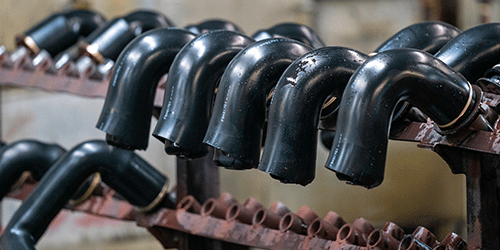It’s a common question: What is the difference between EPDM and neoprene? Is one better than the other? Which one should I use? The answer is, “it depends.”
Let’s start with the similarities. Both EPDM and neoprene are synthetic rubbers that are commonly used in conveyor belts, gaskets, hoses and outdoor applications. Both EPDM and neoprene are excellent for general usage, and both can be molded, extruded and formed to create just about any component you could ever need. That’s where the similarities end.
Let’s start with one of the most important differences: cost. Neoprene is more expensive than EPDM. That’s partially what makes EPDM such an attractive materials choice, but as we’ll show, cost isn’t the only factor to consider, as these two rubbers offer very different properties. It’s important to consider both budget and performance needs into your component engineering decisions.
The main difference between EPDM and neoprene is their basic structure, and the fact that they are produced in different ways. Neoprene production is more involved, hence the higher cost.
EPDM, or Ethylene Propylene Diene Monomer, is composed of ethylene, propylene, and diene monomers and has a single bond molecular structure.
Neoprene is also called “polychloroprene” and is produced by the polymerization of chloroprene. Polymerization is a chemical reaction in which molecules form polymer chains, or three-dimensional networks.
EPDM is vulnerable to oil, gas, and hydrocarbon solvents, but it is resistant to alkalis, acids, and oxygenated solvents. EPDM is resistant to heat, cold, ozone, water, and is weather resistant and holds up well to steam. Its electrical insulating properties are also very high.
Neoprene is oil, alkali, and acid-resistant, but it is susceptible to oxygenated solvents. Neoprene outperforms other rubbers for corrosion resistance and degradation, and is very weather and fire-resistant, with excellent thermal and moisture-insulating properties and waterproofing ability. Neoprene is stretchable, which allows it to be made into equipment and objects of varying sizes.
EPDM is a very widely used material. It is used heavily in the automotive industry for radiator and heater hoses, weatherstripping, seals, O-rings, gaskets, and wire connectors and insulators. EPDM is also used as an insulating material in cold room and walk-in freezer doors, seals in industrial respirators, as pond liners, and in washers, belts, and vibration dampeners.
EPDM is used as electrical cable joining since it is water-resistant, and in roofing membranes, since it does not pollute run-off water. EPDM can also be sprayed onto concrete, asphalt, or brick to create non-slip surfaces in wet areas around pools, playgrounds, and public transportation stations.
Neoprene is available as solid rubber or in sheet form. Neoprene is commonly used in gaskets and belts, vibration mounts, hoses, and weather stripping. It is also used in corrosion-resistant coatings, high-pressure adhesives, as electric insulators, in orthopedic braces, and in marine equipment and roofing materials.
Sperry & Rice has been in the rubber business since the 1940s and works with a wide range of natural and synthetic rubbers. We can help you choose between EPDM and neoprene, depending on your project and how your rubber component will be used.
In fact, during a recent world-wide neoprene shortage, we worked with clients and developed customized alternative rubber solutions to replace the neoprene for their projects. It’s another example of when you work with Sperry & Rice, you work with people that make a difference – for your projects and your business.
Sperry & Rice offers innovative engineering, advanced manufacturing processes, and comprehensive quality controls to produce precision extruded synthetic rubber components for the HVAC, automotive, transportation, and appliance industries. Our reputation lies in making sure that the rubber we provide makes the finished products of our clients reliable, and of the highest quality.
For more information about EPDM or neoprene engineering, contact us!
